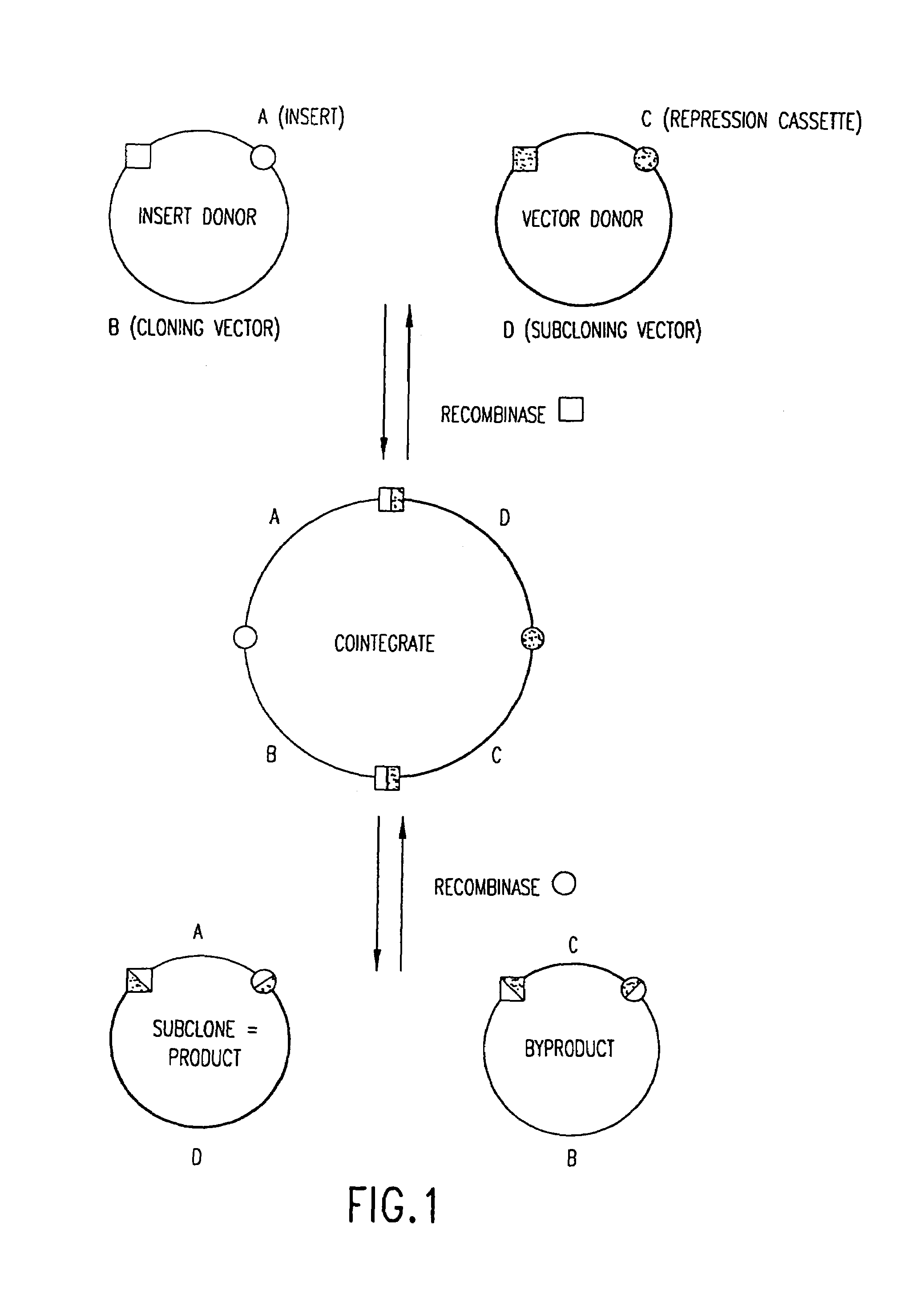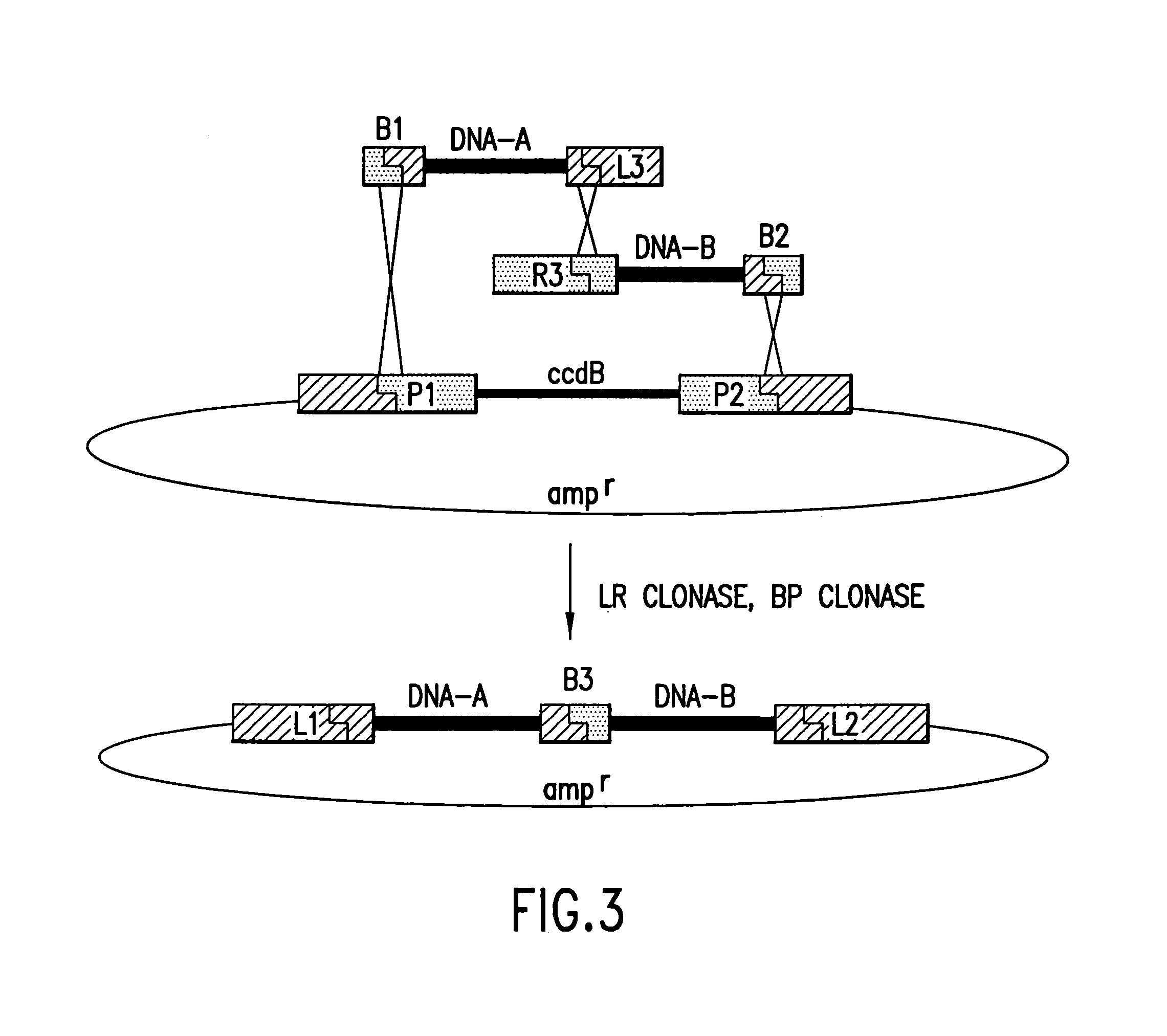Use of multiple recombination sites with unique specificity in recombinational cloning
- Summary
- Abstract
- Description
- Claims
- Application Information
AI Technical Summary
Benefits of technology
Problems solved by technology
Method used
Image
Examples
example 1
Simultaneous Cloning of Two Nucleic Acid Segments Using an LR Reaction
[0478]Two nucleic acid segments may be cloned in a single reaction using methods of the present invention. Methods of the present invention may comprise the steps of providing a first nucleic acid segment flanked by a first and a second recombination site, providing a second nucleic acid segment flanked by a third and a fourth recombination site, wherein either the first or the second recombination site is capable of recombining with either the third or the fourth recombination site, conducting a recombination reaction such that the two nucleic acid segments are recombined into a single nucleic acid molecule and cloning the single nucleic acid molecule.
[0479]With reference to FIG. 2, two nucleic acid segments flanked by recombination sites may be provided. Those skilled in the art will appreciate that the nucleic acid segments may be provided either as discrete fragments or as part of a larger nucleic acid molecul...
example 2
Simultaneous Cloning of Two Nucleic Acid Fragments Using an LR Reaction to Join the Segments and a BP Reaction to Insert the Segments into a Vector
[0504]As shown in FIG. 3, a first nucleic acid segment flanked by an attB recombination site and an attL recombination site may be joined to a second nucleic acid segment flanked by an attR recombination site that is compatible with the attL site present on the first nucleic acid segment and flanked by an attB site that may be the same or different as the attB site present on the first segment. FIG. 3 shows an embodiment wherein the two attB sites are different. The two segments may be contacted with a vector containing attP sites in a BP reaction.
[0505]A subsequent LR reaction would generate a product consisting of DNA-A and DNA-B separated by either an attP site or an attB site (the product of the LR reaction) and cloned into the vector backbone. In the embodiment shown in FIG. 3, the attL and attR sites are arranged so as to generate a...
example 3
Cloning of PCR Products Using Fragments by Converting attB Sites into a Reactive Pair of attL and attR Sites in a BP Reaction and Subsequent LR Reaction
[0518]A similar strategy to that described in Example 2 can be used to recombine two PCR products and clone them simultaneously into a vector backbone. Since attL and attR sites are 100 and 125 base pairs long, respectively, it may be desirable to incorporate attB sites into the PCR primers since an attB site is 25 base pairs in length. Depending on the orientation of the attB site with respect to the nucleic acid segment being transferred, attB sites can be converted to either an attL or attR site by the BP reaction. Thus, the orientation of the attB site in the attB PCR primer determines whether the attB site is converted to attL or attR. This affords the GATEWAY™ system and methods of the invention great flexibility in the utilization of multiple att sites with unique specificity.
[0519]As shown in FIG. 4, two segments (e.g., PCR p...
PUM
| Property | Measurement | Unit |
|---|---|---|
| Volume | aaaaa | aaaaa |
| Volume | aaaaa | aaaaa |
| Volume | aaaaa | aaaaa |
Abstract
Description
Claims
Application Information
 Login to View More
Login to View More - R&D
- Intellectual Property
- Life Sciences
- Materials
- Tech Scout
- Unparalleled Data Quality
- Higher Quality Content
- 60% Fewer Hallucinations
Browse by: Latest US Patents, China's latest patents, Technical Efficacy Thesaurus, Application Domain, Technology Topic, Popular Technical Reports.
© 2025 PatSnap. All rights reserved.Legal|Privacy policy|Modern Slavery Act Transparency Statement|Sitemap|About US| Contact US: help@patsnap.com



